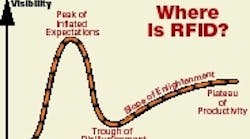Robot manufacturers had their best quarter ever in the first three months of 2005. The Robotics Industries Association (RIA, Ann Arbor, Mich.), whose members account for an estimated 90 percent of the North American robot market, reports that orders rose 30 percent to over 5,300 units compared to the first quarter of 2004. At that pace, orders could exceed 21,000 units for all of 2005, shattering last year's total of 14,838, which was up 20 percent from 2003.
As the story in this issue by long-time contributor George Weimer reports ("Robots: Will Work for Peanuts", page 14), robots have come a long way over the past 20 years. Increased computing power, new materials, refinements of vision technology and many other developments have made robots extremely capable and cost-effective machines. With the largest single segment of robotic applications (45 percent), material handling has been a major beneficiary of these developments. But why is growth taking off now?
Jeff Burnstein, a spokesperson for RIA, attributes the surge to a variety of factors. First is pent-up demand. Because of the slow economy in 2000 and 2001, many companies delayed capital equipment investments.
Perception is another factor. As more stories about robots improving productivity and quality appear in the trade press, and get passed along by word of mouth, the more people understand how today's robotic technology might help their operations become more competitive.
"The more people talk about it, the more success stories there are out there, the more companies understand how robots can help them," says Burnstein. Many organizations that tried robots in the early days were disappointed with the results and subsequently shied away from the technology. Now they are taking another look and finding real opportunities.
Today's industrial robots have reached a point of maturity on the "technology hype curve." The hype curve is an invention of Gartner, Inc. (Stamford, Conn.), an IT industry research firm. It elegantly describes the path that new technologies follow in the market in relation to their exposure in the media. Frenzied publicity leads to over-enthusiasm, contributing to the trough of disillusionment when a new technology fails to meet expectations and falls out of fashion, which is followed by the slope of enlightenment when some businesses continue to experiment and realize the technology's practical applications and benefits. Depending on market appeal and the ability to deliver on promises, some new technologies travel along this path at much faster rates than others.
Contrast the maturity level of robotic technology, which falls somewhere out on the plateau of productivity after several decades, with that of radio-frequency identification (RFID). With the passing of the various deadlines and ultimatums, RFID is no longer making headlines in the popular business press. But it's still the hot topic on the agenda and in the hallways of industry conferences and trade shows, which would imply that RFID continues to move toward the peak of inflated expectations.
Still, there are grumblings among observers that even if RFID tags cost less than 5 cents each, and read rates began to approach 99 percent, many companies would not be able to recoup the investment they've made or would have to make in the technology. Signs of disillusionment if I've ever heard them. And there are real examples, covered in this magazine and elsewhere, where current RFID technology, as imperfect as it may be, has delivered tangible benefits when implemented in the appropriate application.
Where do you think RFID is on the hype curve? How long before it begins to climb the slope of enlightenment? Will it take only a couple of years—as it did with DVD players— or will RFID's benefits remain elusive for 10 years or more?
The Technology Hype Cycle
Source: Gartner, Inc.
David Drickhamer
Editor-in-Chief





